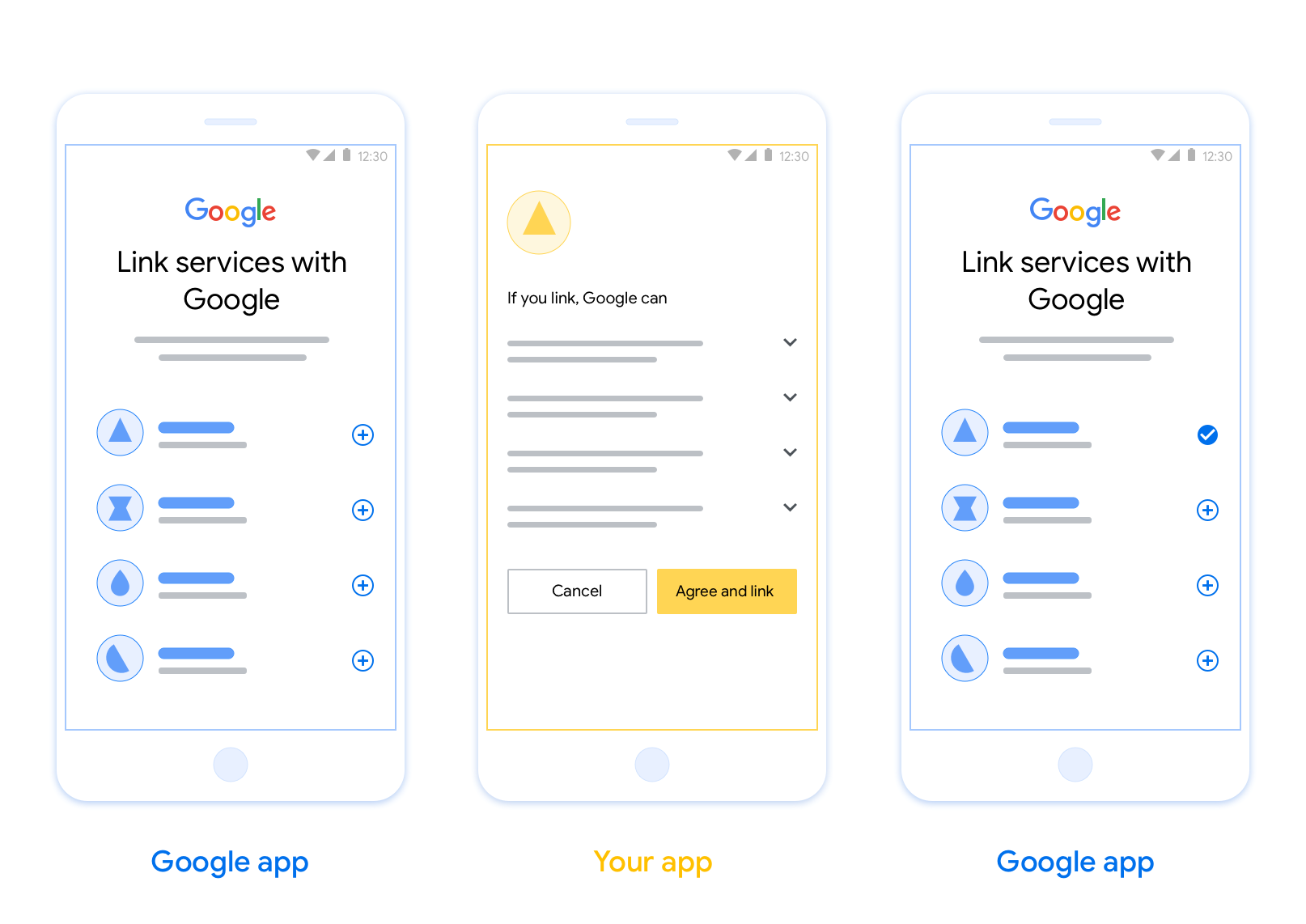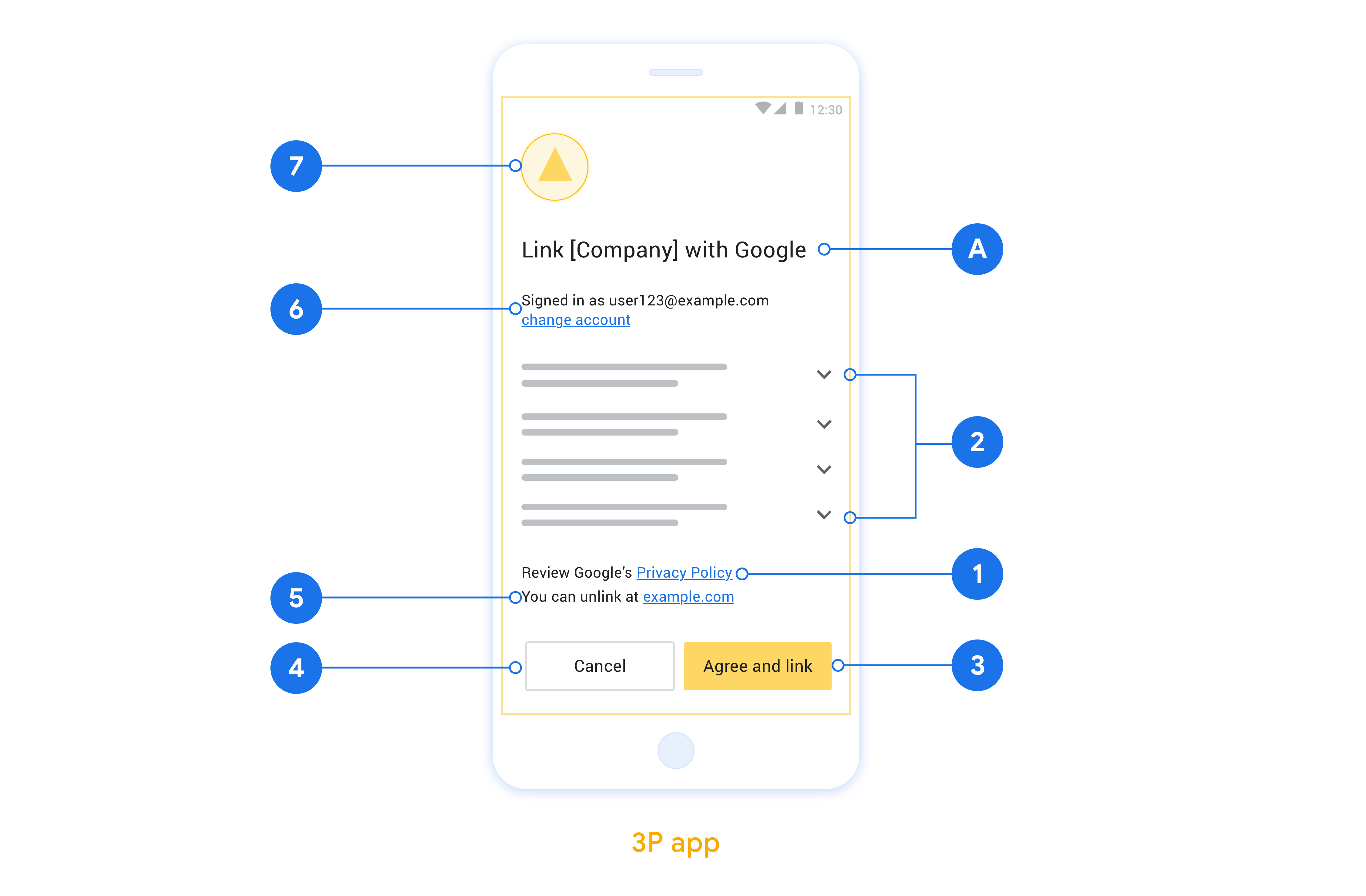OAuth 기반 앱 플립 연결 (앱 플립)을 사용하면 사용자가 인증 시스템의 계정을 Google 계정에 쉽고 빠르게 연결할 수 있습니다. 사용자가 계정 연결 프로세스를 시작할 때 사용자의 휴대전화에 앱이 설치되어 있으면 앱으로 원활하게 전환되어 사용자 승인을 받습니다.
이 접근 방식은 사용자가 인증하기 위해 사용자 이름과 비밀번호를 다시 입력하지 않아도 되므로 더 빠르고 쉽게 연결할 수 있습니다. 대신 앱 플립은 앱에서 사용자 계정의 사용자 인증 정보를 활용합니다. 사용자가 Google 계정을 앱과 연결하면 개발자가 만든 모든 통합을 활용할 수 있습니다.
iOS 및 Android 앱 모두에 앱 플립을 설정할 수 있습니다.

요구사항
앱 플립을 구현하려면 다음 요구사항을 충족해야 합니다.
- Android 또는 iOS 앱이 있어야 합니다.
- OAuth 2.0 승인 코드 흐름을 지원하는 OAuth 2.0 서버를 소유, 관리, 유지해야 합니다.
디자인 가이드라인
이 섹션에서는 앱 전환 계정 연결 동의 화면의 설계 요구사항과 권장사항을 설명합니다. Google이 앱을 호출하면 앱이 사용자에게 동의 화면을 표시합니다.
요구사항
- 사용자의 계정이 Google Home 또는 Google 어시스턴트와 같은 특정 Google 제품이 아닌 Google에 연결된다고 알려야 합니다.
권장사항
다음을 수행하는 것이 좋습니다.
Google 개인정보처리방침을 표시합니다. 동의 화면에 Google 개인정보처리방침 링크를 포함합니다.
공유할 데이터 명확하고 간결한 언어를 사용하여 Google에 필요한 사용자 데이터와 그 이유를 사용자에게 설명합니다.
명확한 클릭 유도 문구 동의 화면에 '동의 및 연결'과 같은 명확한 클릭 유도 문구를 표시합니다. 사용자가 계정을 연결하기 위해 Google과 공유해야 하는 데이터를 이해해야 하기 때문입니다.
거부 또는 취소 기능 사용자가 연결하지 않기로 선택한 경우 뒤로 돌아가거나 거부하거나 취소할 수 있는 방법을 제공합니다.
연결 해제 기능. 사용자가 연결을 해제할 수 있는 메커니즘을 제공합니다(예: 플랫폼의 계정 설정 URL). 또는 사용자가 연결된 계정을 관리할 수 있는 Google 계정 링크를 포함할 수 있습니다.
사용자 계정을 변경할 수 있습니다. 사용자가 계정을 전환할 수 있는 방법을 제안합니다. 이는 사용자가 계정을 여러 개 보유하는 경향이 있는 경우 특히 유용합니다.
- 사용자가 계정을 전환하기 위해 동의 화면을 닫아야 하는 경우 사용자가 OAuth 연결 및 암시적 흐름으로 원하는 계정에 로그인할 수 있도록 복구 가능한 오류를 Google에 전송하세요.
로고를 포함합니다. 동의 화면에 회사 로고를 표시합니다. 스타일 가이드라인에 따라 로고를 배치합니다. Google 로고도 표시하려면 로고 및 상표를 참고하세요.

네이티브 앱에서 앱 플립 구현
앱 플립을 구현하려면 Google의 딥 링크를 허용하도록 앱의 사용자 승인 코드를 수정해야 합니다.
Android 앱에서 앱 플립을 지원하려면 Android 구현 가이드의 안내를 따르세요.
iOS 앱에서 앱 플립을 지원하려면 iOS 구현 가이드의 안내를 따르세요.
앱 전환 테스트
확인된 프로덕션 앱과 작동하는 OAuth 2.0 서버를 사용하기 전에 샘플 및 테스트 앱을 사용하여 앱 플립을 시뮬레이션할 수 있습니다.
앱 플립 중에 Google 앱이 먼저 앱을 연 다음 OAuth 2.0 서버에서 승인 코드 응답을 요청합니다. 마지막 단계에서 응답이 Google 앱에 반환됩니다.
기본 요건
Google 앱을 시뮬레이션하고 앱을 실행하는 인텐트를 트리거하려면 Android 및 iOS용 앱 플립 테스트 도구를 다운로드하여 설치합니다.
앱을 시뮬레이션하고 OAuth 2.0 응답 유형을 선택하려면 Android 및 iOS용 앱 플립 샘플을 다운로드하여 설치합니다.
테스트 시퀀스
- 앱 플립 테스트 도구를 엽니다.
Try Flip!를 눌러 App Flip 샘플 앱을 실행합니다.- 샘플 앱의 라디오 버튼에서 응답을 선택합니다.
Send를 눌러 시뮬레이션된 OAuth 2.0 응답을 테스트 도구로 다시 반환합니다.- 테스트 도구 로그 메시지에서 auth_code 또는 오류 세부정보를 확인합니다.
프로덕션 테스트
등록 및 OAuth 2.0 서버 구현을 완료한 후 프로덕션에서 앱 플립을 테스트할 수 있습니다.
자동 테스트에는 단일 Google 계정과 작업별 이메일 주소를 사용하는 것이 좋습니다.
Google 계정 소유자로 로그인한 경우 연결된 계정을 사용하여 계정 연결 상태를 볼 수 있습니다. 여기에서 반복되는 테스트 간에도 계정의 연결이 해제될 수 있습니다.
원하는 경우 RISC를 구현하여 프로그래매틱 방식으로 연결을 해제하고 Google에 변경사항을 알릴 수 있습니다.
